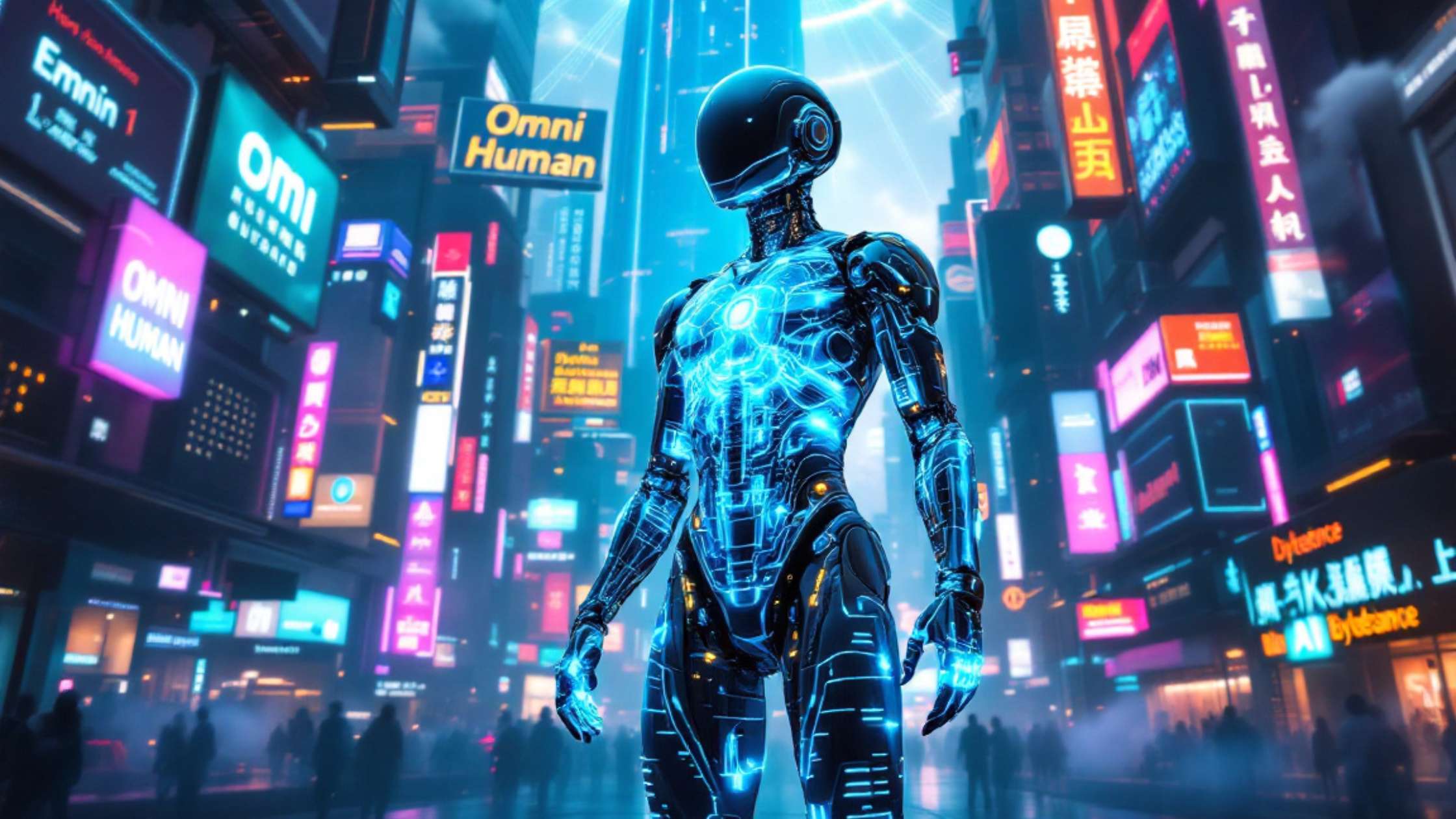Artificial intelligence (AI) has come a long way—from simple rule-based systems to sophisticated neural networks that can mimic human speech, vision, and reasoning. Yet, for all these leaps and bounds, many have yearned for a technology that is more holistic: a solution that doesn’t just excel in a narrow task, but embraces the entire spectrum of human qualities. That’s where Omnihuman AI comes into the picture.
Omnihuman AI is an umbrella term used by visionary developers and tech enthusiasts to describe a form of AI that merges human adaptability, empathy, and creative thinking with the limitless processing power and data analysis capabilities of advanced machine learning systems. Within this expanding universe of omnipotent technology are various specialized solutions, from Bytedance Omni Human and Kling AI to rising stars like Goku AI and Deepseek AI. Each system aims to push the envelope of what’s technologically possible, often aided by open-source ecosystems like Omnihuman GitHub.
In this article, we’ll embark on a narrative journey—an engaging look at how these technologies came to be, where they might go, and how they interact with one another. We’ll also examine the controversies, the pros and cons, and the sentiment of the wider public. Fasten your seatbelts for a deep dive into omni man 1 ai, omnihuman-1, omni human ai app, and an entire kaleidoscope of AI phenomena emerging as the new frontier.
Chapter 1: Setting the Stage—From Narrow to Omnihuman
The Early Landscape of AI
AI began modestly with rule-based systems in the 1950s, formalizing logic and enabling machines to follow instructions with mechanical precision. Over decades, the field progressed through several “AI winters” and “summers.” Eventually, with the advent of deep learning techniques and rapidly expanding computational resources, AI blossomed into tasks like image recognition, language translation, and voice assistance. Yet, even these advanced systems were considered narrow, excelling in specific tasks but lacking a holistic intelligence.
Enter Omnihuman
This is where the idea of omnihuman bursts into the limelight. Imagine an AI model not just capable of identifying objects in a photo or generating text responses, but also capable of blending human creativity, adaptive decision-making, and emotional intelligence into its data-driven logic. Omnihuman AI aims to be that solution—a universal intelligence bridging the gap between narrow machine learning tasks and genuine multi-faceted reasoning.
The path to Omnihuman AI has been paved by the likes of Omnihuman GitHub communities—open-source collaborators who share code, datasets, and research to foster new breakthroughs. The ultimate goal: create a system that seamlessly integrates with human users, from assisting with image to video ai tasks (turning static images into lifelike motion) to leading strategic decisions in healthcare, finance, and beyond.
Chapter 2: Key Players in the Omnihuman Revolution
1. Bytedance Omni Human
One of the most talked-about innovations in this realm is Bytedance Omni Human. Known primarily for its social media apps, Bytedance has quietly been advancing in AI research—particularly in creating models that understand and predict human behavior with uncanny accuracy. Rumors of omni human 1 bytedance gained traction on tech forums, pointing to a robust, multi-faceted AI that could interpret body language, voice tonality, and contextual cues in real time.
Why It Matters
Bytedance’s foray into AI is significant because it’s built upon massive user data and advanced research labs. Reports and analyses, such as those in the South China Morning Post (SCMP), hint at Bytedance’s capability to harness enormous volumes of data to create deepfake-like features that blur the line between real and synthetic. Though exciting, this raises ethical and security questions—a recurring theme in our journey through Omnihuman AI.
2. Goku AI
Inspired by anime culture and fueled by open-source collaboration, Goku AI has quickly become a challenger on the world stage. As reported by Forbes and Analytics India Magazine, Goku AI sets itself apart through high-speed training and efficient resource management, potentially overshadowing American giants in certain tasks.
Goku AI’s Unique Strength
Much like the beloved character from which it borrows its name, Goku AI exhibits “transformative” abilities, quickly adapting to new tasks and frameworks. Early adopters are impressed by its natural language generation and image to video ai transformations. This adaptability has positioned Goku AI as a formidable competitor in the race for truly Omnihuman intelligence.
3. Kling AI
Kling AI brings to mind interstellar exploration. Though lesser-known compared to Goku AI or Bytedance Omni Human, Kling AI focuses on bridging the communication gaps between humans and machines. By harnessing natural language processing (NLP) breakthroughs, Kling AI aims to create interfaces that can interpret not just words, but also tone, sentiment, and intent.
Potential Use Cases
- Customer Service: Kling AI’s advanced NLP could revolutionize automated customer support, making interactions feel more like talking to a friend than a robot.
- Voice-Activated Systems: As voice interfaces proliferate, Kling AI’s context-aware language skills could personalize user experiences far beyond the simple commands we have today.
4. Deepseek
Deepseek stands out for its approach to data retrieval and pattern recognition. The system uses advanced deep learning techniques to sift through vast quantities of data, offering real-time insights in industries like healthcare, finance, and robotics.
The Omnihuman Integration
Deepseek’s specialized focus on large-scale data analysis complements the more user-facing aspects of omni man 1 ai or omnihuman ai. By combining back-end analytics from Deepseek with the front-end empathy and adaptability of Omnihuman systems, we edge closer to a robust, all-in-one AI platform.
5. Pixverse AI, Hailuo AI, Pika AI, Leonardo AI
We can’t discuss the Omnihuman AI ecosystem without touching upon these niche but fast-emerging platforms:
- Pixverse AI: Excels in visual transformations, turning basic sketches into hyper-realistic images and bridging the gap between creative minds and machine output.
- Hailuo AI: Focuses on translation and linguistics. It’s rumored to interpret not just languages but also cultural cues, which is essential for a truly global Omnihuman solution.
- Pika AI: Prioritizes speed and minimal energy consumption, making it ideal for mobile and IoT devices.
- Leonardo AI: Leans heavily into creative solutions, assisting artists, architects, and designers with concept generation, structural simulation, and beyond.
Although each platform has its own unique selling point, they all serve as pieces of the larger Omnihuman AI puzzle, enabling synergy between specialized tasks and a more comprehensive intelligence.
Chapter 3: The Omnihuman AI Ecosystem—Omnihuman-1, Omni Man 1 AI, and More
Omnihuman-1: A Milestone Release
Omnihuman-1 has quickly become a buzzword among tech enthusiasts. The model, rumored to be spearheaded by Bytedance and refined through an omnihuman GitHub collaborative community, integrates multiple AI subfields under a single architecture:
- Computer Vision: Emphasizing image to video ai transformations
- NLP: Advanced context awareness and multi-language capabilities
- Emotional Intelligence: Basic sentiment analysis that’s refined through real-world interactions
Developers working on omnihuman-1 have praised its modular design, allowing them to plug in different components (like pixverse ai for images) without overhauling the entire system.
Omni Man: A Cultural Phenomenon
You may have heard references to “Omni Man” in pop culture, but here it has a distinct technological twist. Omni Man 1 and Omni Man 1 AI describe advanced prototypes that push the boundaries of AI-human synergy. These systems aim to replicate the versatile abilities of superhero-like entities—recognizing that a true Omnihuman AI should be:
- Flexible: Adapting to real-time changes
- Responsive: Offering quick solutions or insights
- Empathetic: Identifying not just what a user says, but how they feel
While the name conjures images of comic-book heroes, the real power behind Omni Man 1 AI is the synergy of advanced deepseek ai analytics, kling ai language processing, and pixverse ai for immersive visuals.
Omni Human AI App
Of course, what’s an Omnihuman revolution without a direct consumer application? The omni human ai app is a single platform combining these cutting-edge services: emotional intelligence, advanced data retrieval, and creative design all in one interface. Think of it as an “AI Swiss Army Knife,” enabling users to:
- Transform images to videos
- Generate human-like text responses
- Analyze complex data
- Receive personalized recommendations
The ambition behind the omni human ai app isn’t just novelty. It aims to democratize AI access, ensuring that people from various backgrounds—developers, marketers, educators, even casual enthusiasts—can harness the power of Omnihuman intelligence with minimal friction.
Chapter 4: Behind the Curtain—How Does Omnihuman AI Work?
Data Gathering and Training
All advanced AI requires massive amounts of data, and Omnihuman systems are no different. The data fueling these models comes from:
- Social Media Interactions: Platforms like TikTok (owned by Bytedance) provide a treasure trove of human behavioral data.
- User-Contributed Data: Open-source channels, including omnihuman GitHub, contain large datasets for training AI to be more ethically and culturally aware.
- Private Sector Partnerships: Collaborations with healthcare, finance, and logistics enterprises enable AI to refine real-world problem-solving skills.
The training process typically involves complex neural network architectures, frequently updated and fine-tuned to ensure minimal bias and optimal performance. Yet, it’s essential to note that ethical considerations such as user privacy, data security, and fairness often become battlegrounds in this evolving space.
Integration of Specialized Modules
Unlike older, monolithic AI systems, Omnihuman AI thrives on modularity:
- Kling AI for natural language understanding
- Deepseek AI for big-data insights
- Pixverse AI for visual and creative tasks
- Hailuo AI for cross-cultural translations
- Pika AI for optimized efficiency
- Leonardo AI for creative concept development
By linking these modules through an overarching framework like omnihuman-1, developers can swap in specialized components as needed, resulting in a scalable, customizable system. This is how omni man 1 or omni man 1 ai can be tailored to suit industries as diverse as healthcare diagnostics and cinematic productions.
Chapter 5: Pros and Cons of Omnihuman AI
Any revolutionary technology comes with its set of advantages and challenges. Below is an honest look at the pros and cons of adopting Omnihuman AI solutions:
Pros
- Enhanced Productivity
- By combining multiple AI capabilities—visual, linguistic, emotional intelligence—Omnihuman AI drastically reduces the need for humans to juggle multiple specialized tools.
- Personalized User Experiences
- Systems like the omni human ai app can adapt to individual preferences, learning from user feedback and historical data to offer customized recommendations.
- Scalability
- Through a modular design, businesses can add or remove AI functions like image to video ai or advanced data analytics with minimal disruption.
- Open-Source Collaboration
- Platforms such as omnihuman GitHub encourage community-driven improvements, fostering transparency and innovation.
- Rapid Integration
- Sectors like finance and education can deploy specialized versions of Omnihuman AI quickly due to pre-trained modules.
Cons
- Ethical and Privacy Concerns
- Large-scale data gathering may infringe upon user privacy. Regulatory bodies have already questioned Bytedance’s data practices in the past.
- Potential Bias
- Any AI is only as good as its training data. Omnihuman AI faces the risk of inheriting biases from datasets, which can manifest in inaccurate or unfair decisions.
- High Computational Costs
- Training and running such a comprehensive model can be resource-intensive, posing challenges for smaller enterprises or developers.
- Vulnerabilities
- With more complexity comes a larger attack surface for cyber threats, making security a paramount concern.
- Overreliance on AI
- A sophisticated AI that appears almost “human” can tempt organizations to over-delegate decision-making to machines, raising questions about accountability and the human element in critical situations.
Chapter 6: People’s Verdict—Enthusiasm and Skepticism
Technology enthusiasts generally hail Omnihuman AI as the next quantum leap in artificial intelligence. Early adopters of prototypes like omnihuman 1 ai or users who have tested omni man 1 ai in closed-beta programs often speak about unprecedented performance in tasks like real-time language translation, dynamic content creation, and empathetic responses during customer service interactions.
However, skeptics warn that the excitement could overshadow potential misuses or unaddressed vulnerabilities. Many fear that the seamless deepfake capabilities—such as turning images to video and replicating human voices—could lead to misinformation campaigns. Others are concerned about how soon automation might replace roles traditionally requiring creative and emotional labor, such as therapy, teaching, or writing.
Public debates often swirl around the role of Big Tech in controlling and commercializing this technology. Bytedance, in particular, has faced scrutiny for potential data mismanagement—sparking ethical questions about corporate responsibility when building systems so closely tied to human-like intelligence.
Chapter 7: Controversies Surrounding Omnihuman AI
No transformative technology is free from controversy, and Omnihuman AI is no exception.
1. Data Ownership and Privacy
Some argue that the drive for an all-encompassing AI—one that can replicate human emotions and behaviors—necessitates an unprecedented level of data. Who owns this data? Critics question whether Bytedance, known for its massive user base, might exploit user data for proprietary gains, without offering adequate transparency or compensation.
2. Ethical Use of Deepfakes
The advanced image to video ai features, popularized by systems like Bytedance Omni Human, are a double-edged sword. While they can bring old family photos to life, they also open up possibilities for malicious deepfakes that can spread misinformation, harass individuals, or disrupt social harmony.
3. Job Market Disruptions
Advanced AI systems like omnihuman 1 or omni man 1 have made leaps in fields once considered safe from automation, including creative domains. This has fueled anxieties about job losses, prompting calls for new regulations and universal basic income measures.
4. Tech Monopolies
With large corporations like Bytedance harnessing these technologies, some experts caution that if a few companies dominate the Omnihuman AI market, it could stifle innovation and concentrate too much power in the hands of a select few.
Chapter 8: The Race to Rank—Why Omnihuman AI Dominates SEO
In today’s digital age, every emerging technology aims to rank high in online search results. Omnihuman AI is no exception, and here’s why it dominates:
- Broad Keyword Range
- Terms like kling ai, goku ai, omnihuman ai, omni human ai app, deepseek, pixverse ai, hailuo ai, pika ai, and leonardo ai showcase the ecosystem’s diversity. This multi-keyword presence allows Omnihuman AI to appear in searches ranging from creative design to big-data analytics.
- Global Relevance
- The integration of multilingual capabilities, through modules like hailuo ai, makes Omnihuman AI relevant in various regions, further boosting its SEO.
- Cross-Sector Adoption
- Education, healthcare, marketing, film production—Omnihuman AI touches upon numerous industries, creating a broad web of backlinks and mentions in specialized publications.
- High Engagement Content
- Viral demonstration videos, user guides, and open-source collaborations on omnihuman GitHub generate consistent user engagement, fueling better search engine visibility.
Chapter 9: Practical Applications and Case Studies
It’s one thing to theorize about Omnihuman AI, but where do we see real-world impact?
1. Healthcare and Diagnostics
Hospitals are pilot-testing omnihuman 1 ai to analyze patient records, spot anomalies faster, and even detect early signs of diseases. Deepseek ai modules within these systems can highlight correlations between symptoms and treatment outcomes, improving patient care.
2. Education
Imagine a classroom where kling ai ensures instant, multi-language translation for students from diverse backgrounds. Meanwhile, leonardo ai can help teachers develop creative lesson plans, and pika ai optimizes course material for digital platforms—cutting across the entire learning experience.
3. Creative Arts
Filmmakers and game developers rely on pixverse ai and image to video ai capabilities for pre-visualization, storyboarding, and even creating lifelike CGI characters. This helps smaller studios produce content that competes with big-budget productions, leveling the creative playing field.
4. E-commerce and Marketing
Businesses deploy the omni human ai app to craft personalized shopping experiences, recommending products based on sentiment and past user interactions. This fosters a deeper emotional bond with consumers, elevating brand loyalty.
Chapter 10: The Future of Omnihuman AI
Where do we go from here? The next phase of Omnihuman AI development is poised to explore:
- Emotional Intelligence: Advancing beyond sentiment analysis to genuine empathy, enabling more supportive interactions in fields like telemedicine and mental health.
- Quantum Computing: Partnerships with quantum technology labs could drastically accelerate the AI’s training speed and computational power.
- Regulatory Frameworks: Governments worldwide are formulating guidelines to ensure transparent data usage, fairness, and accountability in AI-driven decisions.
- Continued Open-Source Collaboration: With more developers engaging on omnihuman GitHub, we can expect faster iterations, breakthroughs, and hopefully more inclusive AI solutions.
The final frontier may be an AI so seamlessly integrated into our lives that it becomes an unobtrusive companion—empowering human beings to innovate, create, and thrive at levels previously unimaginable.
Frequently Asked Questions (FAQ)
- What is Omnihuman AI in simple terms?
Omnihuman AI is an advanced AI concept aiming to replicate not just problem-solving abilities but also human creativity, empathy, and adaptability. It integrates multiple specialized modules—like vision, language, and emotional intelligence—into a unified system. - How does Bytedance Omni Human differ from other AI models?
Bytedance Omni Human is built upon the massive user data collected by Bytedance, giving it an edge in understanding human behavior. It excels in deepfake technology, real-time data analysis, and adaptive user interactions. - What are the main controversies around Omnihuman AI?
Key controversies include data privacy, potential misuse of deepfake capabilities, job market disruptions due to automation, and concerns over tech monopolies controlling powerful AI technologies. - Is Omnihuman AI open-source?
Parts of the Omnihuman AI ecosystem are open-source, particularly through omnihuman GitHub repositories. However, some proprietary modules—especially from large corporations like Bytedance—remain closed-source. - How can I access these Omnihuman AI tools?
Many tools, like kling ai, goku ai, deepseek ai, and pixverse ai, offer APIs or developer kits. Bytedance’s omni human ai app may be available in beta for select users, and you can sign up through their developer portals. - Should I be worried about losing my job to Omnihuman AI?
While Omnihuman AI can automate certain tasks, it also creates new opportunities. History shows that technological advances often shift labor markets, and many experts believe human creativity and emotional intelligence will remain invaluable.
References
- Forbes: Goku AI Challenges OpenAI and the US
- Analytics India Mag: Bytedance Unveils Goku To Take on Google’s Luma and OpenAI’s Sora
- South China Morning Post: Bytedance’s New AI Model Goes Viral
Conclusion: Bridging Human and Machine
Omnihuman AI is more than just another technological milestone—it symbolizes an evolution in how we perceive the intersection of humanity and artificial intelligence. From the advanced deepfake capabilities of Bytedance Omni Human to the open-source brilliance of Goku AI, a new era of synergy is unfolding, promising to augment human capabilities like never before.
Yet, with great power comes great responsibility. While the prospect of human-like machines ignites excitement and opens unprecedented horizons, it also underscores the urgent need for ethical governance, transparency, and public dialogue. In navigating this frontier, a balance must be struck between harnessing the capabilities of Omnihuman AI and preserving the very qualities that make us human: empathy, creativity, and moral judgment.
As the story of Omnihuman AI continues to unfold—through breakthroughs, controversies, and evolving public sentiment—one truth remains unassailable: the conversation has only just begun. By staying informed, engaged, and ethically committed, we collectively have the chance to shape a future where humanity and artificial intelligence don’t just coexist, but thrive in harmony.











Leave a Reply